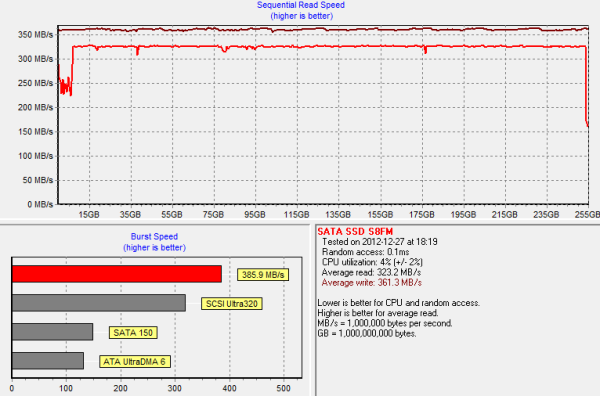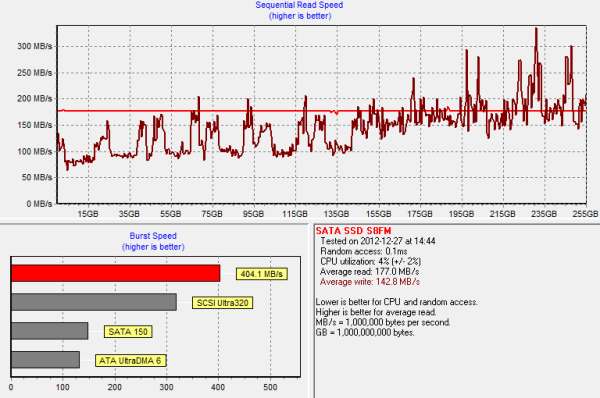MyDigitalSSD SMART & BP3 mSATA SSD Review
by Kristian Vättö on January 22, 2013 1:24 PM ESTPerformance Over Time & TRIM
As the SMART is a SandForce drive with the stock firmware, I decided not to test its TRIM performance because we have tested that so many times, the latest being our article on SandForce TRIM issue. Hence this part will only cover the BP3 but since it's a new, untested controller, this data should be rather interesting. Let's start with HD Tach ran on a secure erased drive:
For our torture test, I filled the drive with sequential data and hammered it with 4KB random writes (100% LBA space, QD=32) for 40 minutes:
Performance is actually fairly good. The worst drop is around 70MB/s right at the beginning but after about half of the LBAs have been written with sequential data, the average data rate is around 200MB/s. Part of the cause for this is the fact that the BP3 has slow random write performance, which means it will write less data to the drive than what faster drives would, resulting in a less fragmented drive.
Next I secure erased the drive, filled it and tortured it again and TRIM'ed after torture:
TRIM performance is rather dubious. Performance is definitely better than without TRIM but it's still far from clean state performance. I have a feeling that the controller itself is not very powerful so it may simply not be able to do garbage collection on all the blocks without some idle time between torture and HD Tach run (I immediately TRIM'ed the drive after torture and began the HD Tach run). It would explain why the performance is over 300MB/s for a large part of the drive. The controller may have cleaned some of the blocks and the first writes go there but in the end it faces a situation where it has to read-modify-write because all blocks are full, and write performance drop to figures similar to after torture test.













49 Comments
View All Comments
ssj3gohan - Tuesday, January 22, 2013 - link
Aside from my usual remarks on using the wrong methodology for idle power consumption (use a DIPM-enabled testbench!), the mSATA slot uses 3.3/1.8V, while your 2,5" adapter provides this power from 5V via an LDO. LDOs are power converters that step down voltage linearly, i.e. 5V 1A in -> 3.3V 1A out (current is conserved), contrary to switching converters that, apart from efficiency losses, try to do this conversion losslessly.This means that when you measured 5V 0.1A for the BP3, the actual drive consumed 3.3V 0.1A, i.e. 0.33W instead of 0.50W.
magao - Tuesday, January 22, 2013 - link
I recently bought a new notebook specifically because it had an mSATA slot. It came pre-populated with a 32GB cache drive and 500GB hard drive.I immediately replaced it with a 1TB drive and the largest mSATA SSD I could get (128GB OCZ Nocti). I put the OS on the hard drive, then configured the SSD as 32GB cache, the rest (~80GB usable) as data.
The stuff I use all the time was then installed onto the SSD (source code repositories, etc). Lots of small files -> SSD.
The OS + 16GB hibernate file are on the hard drive, which means that's space not being taken up on the limited SSD space. Instead the 32GB cache (which is about the same size as the OS + hibernate file combined) ensures the most-used blocks on the hard drive are cached. Of couse, the page file is on the SSD.
Writes to the hard drive are largely sequential as the caching essentially does write-combining.
I've used symlinks to move various settings to the SSD e.g. web browser cache, etc.
I periodically use Resource Manager to check disk activity. There is some write activity to the hard drive, but it's pretty minimal. Right this instance there are only 5 files listed as either reads or writes to the hard drive. I almost never notice that the hard drive is in use - nearly everything performs at SSD speeds.
Would I prefer to have an all-SSD system? Sure? Can I afford it? Well, I could, but I can get better bang for my buck by using the setup above, with very similar results.
tk11 - Tuesday, January 22, 2013 - link
I recently bought one for a Lenovo x230 that I chose in part because it featured an empty mSATA slot. For anyone willing to take the time to install a mSATA SSD for use as the system drive it's a very compelling feature.magnusoverli - Tuesday, January 22, 2013 - link
Hello.First post at AnandTech... :-)
You say that you cannot see why any desktop users would adopt the mSata-standard, and although I can see that it was not initially meant to be a perfect match, I think it may be. It all depends of course on the individual users´ needs and other hardware.
I recently built a new server for multimedia streaming and backup purposes, and went for the ASUS Maximus V Gene mobo. It enables me to have the OS on an "onboard" msata-slot, and leaving all sata slots for data drives. This is, for me, the perfect combination of performance and flexibility.
I can see that others have commented and touched on related topics, but just wanted to let you know that desktop/server-systems and msata really is a beautiful thing!
M
JarredWalton - Tuesday, January 22, 2013 - link
Except, as noted above, mSATA is set to be replaced by M.2 this year. That's where more SSDs and motherboards are likely to head in the future.magnusoverli - Tuesday, January 22, 2013 - link
Granted that msata is a standard that is about to fade out, isn´t that the reality for just about any standard that has become, or is about to become, mainstream.Also, how long does it take before a new standard is introduced, before it is ready for the main stage? There are only a very few users standing by being ready to upgrade when the first products hits the shelves.
Also, I think that one should maximize the usage of current technologies (within budget) and not stay on the side-lines, always waiting for the next big thing.
But, hey.. That´s just me! ;-)
Death666Angel - Wednesday, January 23, 2013 - link
DDR1/2/3, DVI/HDMI/DP, SATA 1 through 3, USB 1 through 3.All the important standards are either very long lived (5 years for DDR3 now) or are backwards compatible or can be easily used with simple adapters. That is not the case with mSATA. It was niche to begin with, it stayed niche even when there was a big demand for fast, small storage in ultrabooks and tablets and now it is being phased out.
Kristian Vättö - Wednesday, January 23, 2013 - link
But can you use the six SATA headers on the motherboard simultaneously with the mSATA slot? The fact is, mSATA does not add SATA connectivity, it takes one port just like a regular SATA port on the mobo does. It's of course possible that there is a third party SATA controller that provides a few extra ports but those exist without mSATA as well.Not trying to belittle mSATA and the comments here have been mind-opening, I seriously hadn't heard that people actually use mSATA SSD in desktops. Sure I've seen a few but it's good to heat that mSATA SSDs aren't just decorations.
iwod - Tuesday, January 22, 2013 - link
Assuming SATA Express will bring us performance of Today's top SSD in RAID, which still isn't fast enough for Apps to pop out, Startup and Shutdown to be less then 2 seconds,is software the limitation now? Or we need faster CPU?
Zink - Tuesday, January 22, 2013 - link
I'm running a mSATA drive from Adata in my Lenovo laptop and I love being able to pull the optical drive and run three drives in a normal laptop. Boot drive + data drive + hotswap drive for temporary projects.